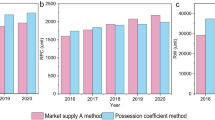Abstract
In the late 1960s and early 1970s, increasing public concern in the United States about automobile graveyards resulted in the development of current automobile recycling technology. However, due to changes in automobile manufacturing practices, the future applicability of existing automobile recycling technology is uncertain. This paper reviews the technological and political trends as they relate to the recycle of automobiles. Recycling practices for steel, aluminum, lead, and platinum-group metals are outlined, and research efforts on alternative approaches are discussed.
Similar content being viewed by others
References
Al Wrigley, “Judging the Material Winners,” American Metal Market (March 29,1993).
Metal working News (February 26, 1990), p. 4.
Rober W. Roig et al., “Impacts of Material Substitution in Automobile Manufacture on Resource Recovery,” EPA-600/5-76-007a (July 1976), PB 257 542, U.S. Environmental Protection Agency, Washington, D.C.
Itaru Niimi, “The Japanese Picture,” The Impacts of Material Substitution on the Recyclability of Automobiles (New York: American Society of Mechanical Engineers, 1983).
Howard Ness, “The Automobile Scrap Processing Industry,” The Impacts of Material Substitution on the Recyclability of Automobiles (New York: American Society of Mechanical Engineers, 1984), pp. 39–98.
R.E. Brown, Iron and Steel Scrap-1991 (Washington, D.C.: U.S. Bureau of Mines).
R.E. Brown, Mineral Industry Surveys (Washington, D.C.: U.S. Bureau of Mines, 1992).
American Iron and Steel Institute, “Steel Production by Process Through April, U.S.A.,“ Iron and Steelmaker, 18(7) (July 1991), p. 13.
Electric Arc Furnace Dust–1993 Overview, prepared by Arthur D. Little for the Center for Materials Production, CMP Report No. 93-1 (July 1993).
R.H. Nafziger, internal U.S. Bureau of Mines report on American Foundrymen’s Society Charge Materials Committee (8-G) and Cupola Committee (8-F) Meeting in Des Plaines, IL, Sept. 16 and 23, 1992.
M.H. Munden et al., “Investigation of Surface Cracking Experienced at the Round Oak Steel Works,” International Conference on the Casting and Solidification of Metals (London: The Metals Society, 1979), pp. 279–289.
M.M. Wolf, “Fine Intergranular Surface Cracks in Bloom Casting,” Trans ISIJ, 24 (1984), pp. 351–358.
J.A. McNichol, “Some Aspects of the Effect of Copper in Cast Iron and Steel,” The Australian Engineer (October 7, 1953), pp. 54–60.
I. Jimbo, M.S. Sulsky, and R.J. Fruehan, “Thermodynamics of Copper Removal from Copper-Saturated Iron with FeS-Na2S-Cu,S Matte,” Proceedings of W.O. Philbrook Memorial Symposium (Warrendale, PA: Iron and Steel Society of AIME, 1988), pp. 133–144.
V.G. Leak and M. Fine, Report of Investigation 7809 (Washington, D.C.: U.S. Bureau of Mines, 1973).
A.W. Cramb and R.J. Fruehan, “A New Process For Copper Removal From Ferrous Scrap,” Iron and Steelmaker, 18 (November 1991), pp. 61–68.
K. Tokinori, H. Ohshita, and M. Iwase, “Removal of Copper from Solid Ferrous Scrap Using Molten Aluminum,” Proceedings of the 49th Electric Furnace Conference (Warrendale, PA: Iron and Steel Society, 1991), pp. 113–120.
A.D. Hartman, L.L. Oden, and D.L. Davis, “Copper Removal from Solid Ferrous Scrap by Solid/Gas Reaction,” to be presented at the 1994 TMS Annual Meeting and to be published in Iron & Steelmaker during 1994.
P.A. Plunkert, Recycled Metals in the United States (Washington, D.C.: U.S. Bureau of Mines, 1993).
J.S. Viland, “A Secondaryś View of Recycling,” Second International Symposium on Recycling of Metals and Engineered Materials, eds. Jan H.L. van Linden, Donald L. Stewart, Jr., and Yogeshwar Sahai (Warrendale, PA: TMS, 1990), pp. 21–31.
C.L. Kusik and C.B. Kenahan, Energy Use Patterns for Metal Recycling, 1C 8781 (Washington, D.C.: U.S. Bureau of Mines, 1978).
H.L. Tiwari, “Demagging Processes for Aluminum Alloy Scrap,” J. Metals, 34(7) (1982), pp. 54–58.
H.L. Tiwari, R.A. Sharma, and B.J. Howie, “Electrolytic Extraction of Magnesium from Commercial Aluminum Alloy Scrap,” Proceedings of International Symposium on Physical Chemistry of Extractive Metallurgy (Warrendale, PA: TMS, 1985), pp. 147–164.
M. Gerlach, “Factory Experience of the Vacuum Treatment of Aluminum Melts,” Proceedings of Molten Aluminum in Foundries and Metallurgical Plants (1981), pp. 85–100.
J. Harbertson, F. Disnayuga, and R. Harris, “Vacuum Refining as a Process Option in Recycling Aluminum Scrap,” Proceedings of International Symposium on Recycle, Secondary Recovery (Warrendale, PA: TMS, 1985), pp. 97–105.
J.E. Murphy and J.J. Lukasko, “Vacuum Distillation of Magnesium and Zinc From Aluminum Scrap,” Light Metals 1993 (Warrendale, PA: TMS, 1993).
Daniel L. Edelstein, “Lead,” Recycled Metals in the United States (Washington, D.C.: U.S. Bureau of Mines, 1993), pp. 33–35.
R. Jolly and B. Bied-Charreton, “Lead Recycling: The Recycling of Lead-Acid Batteries,” Proceedings of the International Conference on The Recycling of Metals (Materials Park, OH: ASM Int., 1992).
D. Eby, “Electric Arc Smelting at RSR Corporation,” Lead-Zinc ’90, Proceedings of a World Symposium on Metallurgy and Environmental Control, eds. T.S. Mackey and R.D. Prengaman (Warrendale, PA: TMS, 1990), pp. 825–840.
E.R. Cole, A.Y. Lee, and D.L. Paulson, “Recovery of Lead from Battery Sludge by Electrowinning,” J. Metals (August 1983), pp. 42–46.
P.B. Queneau, B.J. Hansen, and D.E. Spiller, “Recycling Lead and Zinc in the United States,” Proc. of the Fourth Int’l. Hydrometallurgy Symposium (Littleton, CO: SME, 1993).
M. Olper, “A Full Electrochemical Approach in Processing Junk Batteries,” EPD Congress 1993, ed. J.P. Hagar (Warrendale, PA: TMS, 1993), pp. 959–966.
C.E. Cunningham, “Pre-Recovery-Systemand Recovery-System Losses of Platinum Group Metals Contained in Automotive Catalytic Converters,” Conservation and Recycling, 8(3/4) (1985), pp. 343–357.
R.J. Kuczynski, G.B. Atkinson, and L.A. Walters, High-Temperature Cyanide Leaching of Platinum-Group Metals From Automobile Catalysts—Process Development Unit, RI 9428 (Washington, D.C.: U.S. Bureau of Mines, 1992).
J.E. Hoffman, “Recovering Platinum-Group Metals From Auto Catalysts,” J. Metals, 40(6) (1988), pp. 40–44.
R.J. Schmitt, “Automobile Shredder Residue—The Problem and Potential Solutions,” Center for Materials Production, Report No. 90-1 (January 1990).
B.J. Jody et al., “Chemical and Mechanical Recycling of Shredder Fluff,” Proceedings of Pollution Prevention Conference for Iron and Steel Industry (Chicago: 1992).
B.J. Jody et al., “Recovering Recyclable Materials from Shredder Residue,” JOM, 46(2) (1994), pp. 40–43.
Author information
Authors and Affiliations
Rights and permissions
About this article
Cite this article
Bhakta, P.N.H. Recent technology and trends in automotive recycling. JOM 46, 36–39 (1994). https://doi.org/10.1007/BF03222555
Published:
Issue Date:
DOI: https://doi.org/10.1007/BF03222555




